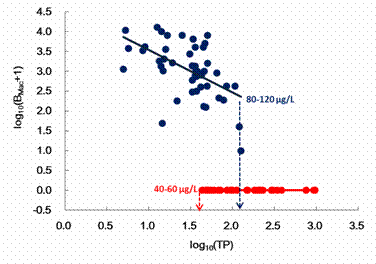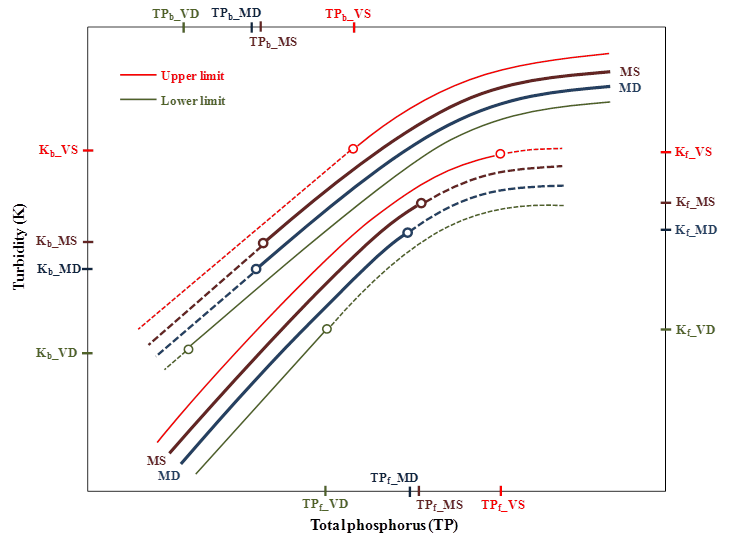
Newsroom
Scientists Discover Rules of Variation in Total Phosphorus Thresholds for Regime Shifts in Shallow Lakes
As one of the most serious problems in shallow lakes, eutrophication is causing shifts of the lakes from a clear-water state dominated by submersed macrophytes to a turbid-water state dominated by phytoplankton. Recovery of submersed macrophytes has been widely recognized as an important measure in lake restoration. However, few convincing successful cases have been reported. This is mainly because the rules of variation in nutrients thresholds for regime shifts are still unclear. According to the theory of alternative stable states, lake stabilizes in a clear-water state at low nutrient levels, while in a turbid-water state at high nutrient levels. The possibility to recover submersed macrophytes occurs merely at intermediate nutrient levels, where two alternative states exist. Researches on the rules of variation in nutrients thresholds for regime shifts are therefore of practically importance.

Fig.1. Relationships between total phosphorus (TP, μg/L) and submersed macrophyte biomass (BMac, g/m2) in Yangtze subtropical shallow lakes. Blue, vegetation-present,n=48; Red, vegetation-absent,n=28.
Previously, total phosphorus in lake water (TP) has received widest attention in relevant researches on thresholds for the regime shifts. Modelling works suggested that the thresholds vary with forms of lake basins and climates. However, such hypotheses remain untested by direct field evidence. The Research Group of Taxonomy and Ecology of Benthos lead by Prof. WANG Hongzhu from Institute of Hydrobiology, Chinese Academy of Sciences (IHB) therefore tested the hypotheses through a combination of multi-lake comparisons and long-term monitoring.
In the researches, TP thresholds were found to vary little at moderate depths and area in lakes from temperate to subtropical (probably to tropical) zones, being 80-120 mg m-3 for the forward shift from a clear-water state to a turbid-water state and 40-60 mg m-3 for the backward shift (Fig. 1); but to decrease notably when depth exceeds a level of probably 3-4 m, and increase sharply when depth is below a level of around 1-2 m (Fig. 2).
Three new viewpoints are presented in this research, i.e. the divergence of turbidity thresholds between forward and backward shifts, the minor variations in TP thresholds at moderate depth, and the subequality of TP thresholds for common shallow lakes in different climatic zones. In contrast to the prediction by published models, the findings suggest that, according to the subequality of TP thresholds, similar target concentrations for in-lake TP can be set in most shallow lakes world-wide to mitigate eutrophication.
 |
| Fig.2. Schematic diagram depicting the effects of water depth on the critical thresholds for regime shifts in shallow lakes. f, forward shifts from a clear-water state to a turbid-water state; b, backward shifts from a turbid-water state to a clear-water state. VS, very shallow; MS, moderately shallow; MD, moderately deep; VD, very deep. |
If TP is much higher than 100 mg m-3, the only option is to control the phosphorus loading. If TP approaches 100 mg m-3, lowering water depth to 1-2 m or less, especially in spring, will increase the thresholds for regime shifts to accelerate ecological restoration. When TP lies between 50-100 mg m-3, perturbations such as biomanipulation and water-level regulation can promote a shift from turbid to clear state. When TP is lower than 50 mg m-3, no extra action is needed after relieving non-nutrient stresses of vegetation such as herbivorous fishes.
The research was supported by the National Natural Science Foundation of China, 973 Programs, the Chinese Academy of Sciences, and the State Key Laboratory of Freshwater Ecology and Biotechnology. The relevant article has been published online in Freshwater Biology (Hai-Jun Wang, Hong-Zhu Wang, Xiao-Min Liang and Shi-Kai Wu. 2014. Total phosphorus thresholds for regime shifts are nearly equal in subtropical and temperate shallow lakes with moderate depths and areas. http://onlinelibrary.wiley.com/doi/10.1111/fwb.12372/full).